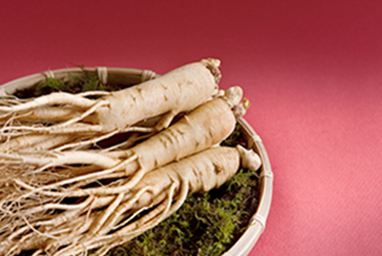Characteristics and Effects of Geumsan Ginseng
Characteristics of Geumsan ginseng

During the growth of Geumsan ginseng, the shape changes. In the first year, as the roots become enlarged, 30 to 40 slow roots are produced. During the transplantation in the second year, all the slow roots are cut off, and only the main roots are planted, and the slow roots appear again. The number of branches and slow roots is fixed, and during cultivation for 4 to 5 years, the main roots become enlarged and the growth of slow and fine roots is promoted, completing the unique shape of ginseng.
The six-year-old root processed with red ginseng has an enlarged head, the body is 7-10 cm long, 2-3 cm in diameter, and has several slow roots. On the other hand, if it grows for more than 7 years, hypertrophic growth becomes slow, the body shape becomes poor, and the epidermis becomes woody. In addition, many voids and voids occur during processing.
The overall shape of the Geumsan ginseng root has many fine roots, including the main root, There is me, and it resembles a human form.
Geumsan ginseng, carrying 1,500 years of history
A passage has been discovered in the medical text Shen Nong Bencaojing, written by scholar Tao Hongjing in Northern and Southern Dynasties-period China, praising the excellence of ginseng from Geumsan. This is documentary evidence for the long history and excellence of Geumsan ginseng. Geumsan ginseng, which has 1,500 years of history, begins to be harvested in early July, when its medicinal qualities are at their peak. Processing is completed by the end of October, and it is referred to as summer ginseng.
Characteristics
- Ginseng is strongly affected by the growing environment, geography, and growing period. Geumsan has a wide temperature difference between night and day, and has all the ideal climate factors for ginseng cultivation.
- Geumsan ginseng is smaller than ginseng grown in other areas, but it is firm and has a pure white color.
- Geumsan ginseng, which has 1,500 years of history, begins to be harvested in early July, when its medicinal qualities are at their peak. Processing is completed by the end of October, and it is referred to as summer ginseng.
- Geumsan ginseng (summer ginseng) has 5.2% content of saponins, the main medicinal component of ginseng, which is far more than ginseng grown in other areas. (Reference: Geumsan Ginseng as a Cultural Property, Sungi Kim, 1998)
The effects of Geumsan ginseng

Sapona, which means soap in Greek, is derived from saponin, which in general lowers the surface tension of water, so it foams easily. If you think that saponin enters the human body and washes blood vessels and organs with soap, you can easily understand the efficacy of saponin.
Plants containing saponins
Although it is contained in small amounts in various plants such as beans, deodeok, buckwheat, bellflower, water parsley, mung bean, garlic, onion, ginkgo biloba, and arrowroot, which are commonly found around us, the saponins of ginseng are different from other plant-based saponins in chemical structure. It is called Ginsenoside, which is a compound word of Ginseng + Glycoside.
Ingredients of ginseng saponin
- Geumsan ginseng has more types of saponins than foreign ginseng such as Hwagi ginseng, ginseng ginseng, and bamboo jeolsam, as well as PD-type ginseng. The composition of the PT system and the PT system show a balanced ratio, so it plays a role in regulating the balance of the body such as blood pressure and body temperature.
- In the process of making red ginseng from raw ginseng, the composition changes. Panaxadiol-based (PD) saponins contain acidic malonyl ginsenosides (m-Rb1, m-Rb2, m-Rc, m-Rd) contained in raw ginseng or white ginseng. is changed into neutral ginsenosides (Rb1, Rb2, Rc, Rd), which are converted into trace ginsenosides Rg3, Rk1, Rg5, etc. as red ginseng progresses. Panaxatriol (PT) saponins Re and Rg1 are converted into trace amounts of Rg2 or Rh4.
The medicinal effects of Korean ginseng
Korean ginseng contains a high amount, 60–70%, of carbohydrates such as starches. However, it also contains special compounds which can't be found in other plants such as ginsenosides, polyacetylene, antioxidant aromatic compounds, gomisin-N and gomisin-A which protect the liver, and insulin-like acid peptides. In particular, non-saponin compounds are the major components, and include phenol and polyacetylene components which activate anti-oxidation and suppress the proliferation of cancer cells. Korean ginseng contains more of these components than North American ginseng, making it more effective for increasing vitality.
effects
- The main medicinal effects of Korean ginseng are known to come from a type of saponin called a ginsenoside, which has not been observed in other plants. It not only has an unusual chemical structure, but also extremely unusual effects. With the development of separation analysis, the chemical structures of 30 types of ginsenosides have been discovered so far.
- Based on the characteristics of the chemical structures of ginsenosides, they are categorized into the protopanaxadiol (PD), protopanaxatriol (PT), and oleanane groups of saponins. The numbers of ginsenosides which have been discovered in each group are respectively nineteen, ten, and one.
- There are a total of 30 types of saponin found in Korean ginseng, far more than the 14 types found in North American ginseng or the 15 types found in Chinese ginseng.
Comparison of saponins of ginseng from each country
| Ingredients/Classification | Korean Ginseng | Hwagisam (American ginseng) |
Jeon Chil Ginseng (Chinese ginseng) |
Pickled Ginseng (Japanese ginseng) |
|
|---|---|---|---|---|---|
| red ginseng | white ginseng | ||||
| Total number of sanopins | 30 kinds | 23 kinds | 14 kinds | 15 kinds | 8 kinds |
| Panaxadiol | 19 | 15 | 9 | 6 | 3 |
| Panaxatriol | 11 | 7 | 4 | 9 | 4 |
| olean | 1 | 1 | 1 | - | 1 |